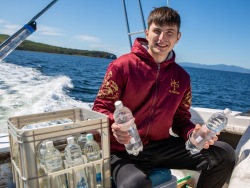Primorsky Aquarium hosting scientific research on phytoplankton

Over the past decade, waters adjacent to the shores the Primorsky Aquarium and its marine mammal research facility lie on have been closely monitored by Aquarium’s researchers.
Throughout the year, at least twice a month, surface waters are sampled and then analyzed at the lab of the Primorsky Aquarium Shared Equipment Facility where specialists assess phytoplankton species composition.
This monitoring aims to study dynamics of algal species in Paris and Zhitkov Bays off Russky Island, which is very important to evaluating the impact of marine mammals kept in sea-pen enclosures in these bays on the phytoplankton community.
“It is well known that microalgae are bioindicators of water quality and habitat conditions,” said Dr. Anna Ponomareva, Director of the Primorsky Aquarium Shared Equipment Facility. “Due to the sensitivity of phytoplankton communities to changes in physical and chemical properties of water, their structure is considered to be one of the most precise indicators. Analysis of the water quality and shifts in phytoplankton community in close proximity to the sea-pen enclosures allows us to assess to what extent the marine mammals influence the aquatic environment and are themselves influenced by it. Now we can state with confidence that the waters of Paris and Zhitkov Bays are not negatively affected by our animals kept in the enclosures.”
The long-term observations have resulted in the finding of some 20 species of microalgae new to Russia and the Sea of Japan/East Sea. The data obtained have been presented at Russian and international conferences and symposia; they have been used in more than 30 scientific papers and in a Bachelor's thesis and a Master's dissertation, which have been successfully defended.
One of the focus areas in phytoplankton monitoring is observing dynamics of toxic algal species. During the observation period, the cell numbers of potentially toxic species were within acceptable limits. However, the mere presence of these species requires ongoing surveillance of phytoplankton to take timely measures for preventing damage to our marine mammals. Toxic algal blooms may cause harm to human, animal, or aquatic ecosystem health.
You can find out more about the phenomenon called “red tides” or “HAB” (harmful algal blooms) in the Microworld exhibit.